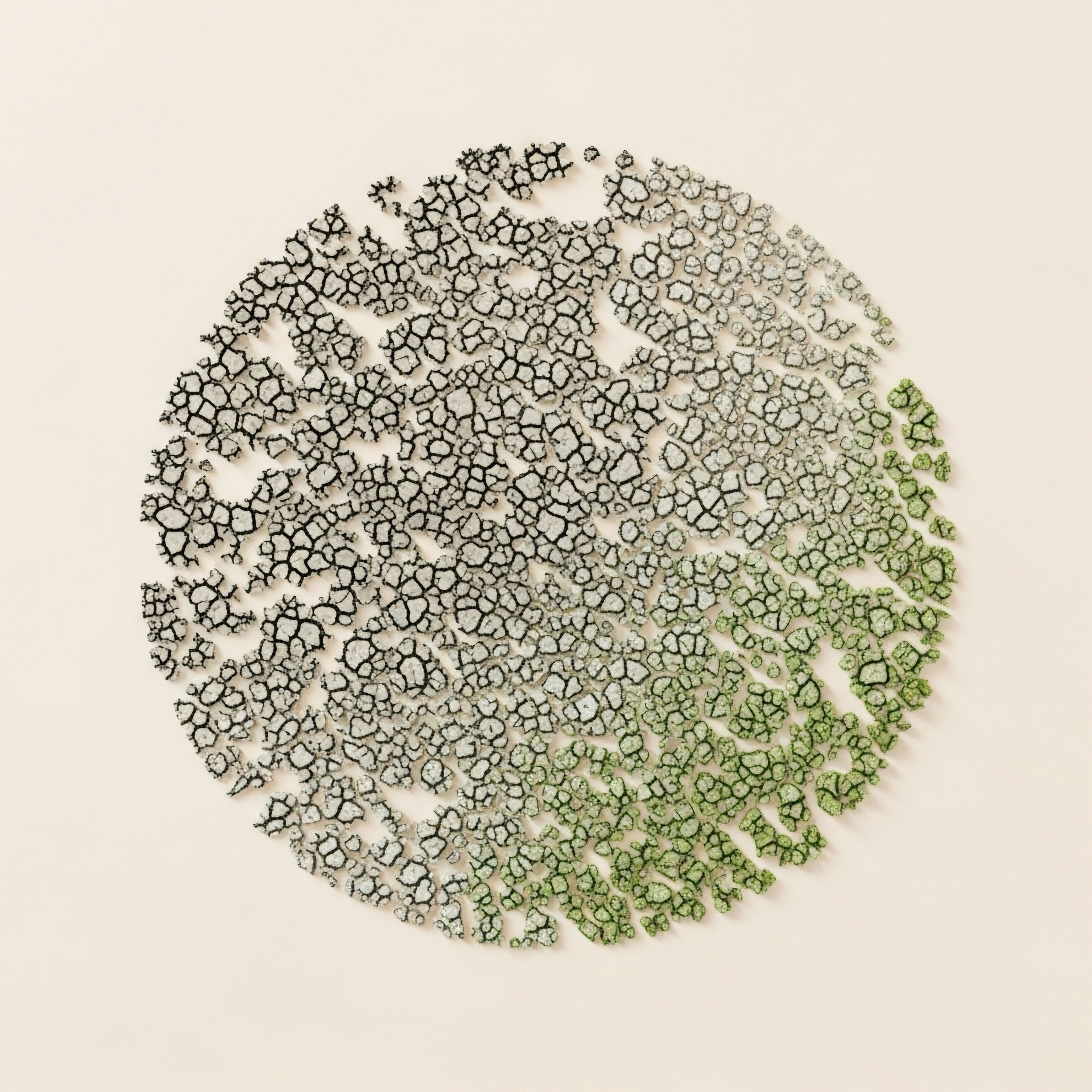

Fundamentals
The conversation surrounding personal appearance often centers on external interventions, yet the true genesis of vitality and aesthetic expression resides within the intricate symphony of our biological systems. When you observe changes in your skin’s resilience, the luster of your hair, or the subtle contours of your physique, these are often outward signals reflecting deeper shifts in your internal biochemical landscape. Your body possesses an inherent intelligence, and understanding its language provides the key to reclaiming optimal function.
Hormonal health, in particular, exerts a profound influence on what we perceive as beauty. Hormones serve as the body’s primary messengers, orchestrating a vast array of physiological processes, from cellular regeneration to metabolic regulation. A decline or imbalance in these vital chemical communicators directly impacts the integrity of dermal structures, the vigor of hair follicles, and the even distribution of subcutaneous adipose tissue.
This foundational understanding allows for a more informed approach to personal well-being, moving beyond superficial remedies to address the core mechanisms of cellular health.
Personal beauty originates from deep physiological balance, a reflection of the body’s intricate internal harmony.

How Do Hormones Shape Skin and Hair?
The skin, our largest organ, actively responds to hormonal fluctuations throughout life. Estrogens, for instance, play a significant role in maintaining dermal thickness, enhancing hydration, and promoting the synthesis of essential proteins such as collagen and hyaluronic acid. These components are fundamental to the skin’s plumpness, elasticity, and overall youthful appearance. A robust dermal matrix, rich in these elements, exhibits a smoother texture and a diminished presence of fine lines.
Hair follicular dynamics also exhibit considerable sensitivity to endocrine signals. Testosterone, often primarily associated with male physiology, also performs crucial functions in women. Appropriate levels support the anagen, or growth, phase of scalp hair, contributing to its density and strength. Progesterone, another vital female hormone, contributes to skin elasticity and helps regulate sebum production, influencing the skin’s moisture barrier and its overall radiance. The interconnectedness of these hormonal actions underscores a holistic view of personal presentation.
- Estrogen ∞ Promotes skin hydration, collagen production, and epidermal thickness.
- Testosterone ∞ Supports scalp hair growth in women with androgen deficiency and influences muscle tone.
- Progesterone ∞ Enhances skin elasticity, reduces wrinkles, and regulates sebum.


Intermediate
Transitioning from foundational concepts, a deeper exploration reveals how specific hormonal optimization protocols directly influence the biological underpinnings of personal appearance. Hormonal recalibration involves carefully tailored interventions designed to restore physiological balance, thereby revitalizing tissues and systems that contribute to external vitality. These protocols operate through precise biochemical pathways, impacting everything from the structural integrity of the skin to the metabolic efficiency of adipose tissue.
Consider the impact of targeted hormonal support on the skin’s architecture. Estrogen, when appropriately replenished, stimulates fibroblasts within the dermis to increase collagen synthesis. Collagen, the most abundant protein in the skin, provides tensile strength and structural support. Elevated estrogen levels also boost the production of hyaluronic acid, a glycosaminoglycan with an extraordinary capacity to bind water, thereby enhancing skin hydration and plumpness. These combined actions visibly improve skin texture, reducing the appearance of laxity and fine lines.
Targeted hormonal optimization protocols precisely recalibrate the body’s internal environment, enhancing outward vitality.

How Do Specific Protocols Impact Dermal Health?
Testosterone Replacement Therapy (TRT), particularly in women experiencing androgen deficiency, offers compelling benefits for hair health. While excessive androgens can contribute to hair thinning in genetically predisposed individuals, appropriately dosed testosterone has demonstrated an anabolic effect on scalp hair follicles, promoting regrowth and increased density in many women. This highlights the importance of individualized dosing and careful monitoring to achieve therapeutic outcomes without adverse effects.
Progesterone supplementation also plays a role in enhancing dermal quality. Research indicates that progesterone improves skin elasticity and firmness, while also contributing to a reduction in wrinkle depth. It influences the skin’s natural repair mechanisms and helps maintain a healthy skin barrier through its regulatory effects on sebum production. The interplay between progesterone and estrogen is particularly significant, as a balanced ratio supports optimal skin hydration and resilience.

Clinical Protocols and Aesthetic Outcomes
The precise application of hormonal optimization protocols involves a nuanced understanding of individual needs. For women, this often includes a combination of estrogen and progesterone, sometimes with low-dose testosterone. For men, testosterone cypionate protocols address symptoms of andropause, which can include improvements in muscle mass, body composition, and skin quality.
| Hormone | Primary Aesthetic Benefit | Underlying Mechanism |
|---|---|---|
| Estrogen | Increased skin thickness, hydration, elasticity | Stimulates collagen, hyaluronic acid synthesis; enhances keratinocyte mitosis. |
| Testosterone | Improved scalp hair density, muscle tone, reduced fat | Anabolic effect on hair follicles; promotes lean muscle mass and fat metabolism. |
| Progesterone | Enhanced skin firmness, elasticity, reduced wrinkles | Supports collagen production; regulates sebum and skin repair processes. |
These interventions aim to restore a physiological state conducive to cellular repair and regeneration, which in turn manifests as improved skin texture, enhanced hair vitality, and a more sculpted physique. The journey toward revitalized appearance is a testament to the profound connection between internal biochemistry and external expression.


Academic
Delving into the intricate molecular architecture of human physiology reveals how hormonal optimization protocols exert their profound effects on the external phenotype, particularly concerning dermal integrity and adnexal structures. The skin, far from being a passive barrier, actively participates in endocrine signaling, expressing a comprehensive array of hormone receptors and enzymes capable of local hormone synthesis and metabolism. This inherent endocrine activity of the skin underscores its role as a dynamic interface reflecting systemic biochemical states.
The influence of estrogens on skin health provides a compelling example of this intricate interplay. Estrogen receptors (ERα and ERβ) are ubiquitously expressed in various dermal cell types, including fibroblasts, keratinocytes, and melanocytes. Activation of these receptors by exogenous or endogenous estrogens triggers a cascade of intracellular signaling pathways.
Specifically, estrogen binding to ERβ on dermal fibroblasts upregulates the transcription of genes responsible for type I and type III procollagen synthesis. Concurrently, it stimulates the production of hyaluronic acid synthase, thereby augmenting the skin’s capacity for water retention and viscoelasticity.
Hormonal optimization profoundly influences external phenotype by modulating intricate molecular pathways within the skin and its appendages.

How Does Endocrine Recalibration Influence Cellular Dynamics?
Beyond collagen and hyaluronic acid, estrogens modulate the activity of matrix metalloproteinases (MMPs), enzymes responsible for collagen degradation. A favorable balance, shifted towards synthesis over degradation, contributes to the maintenance of dermal thickness and structural resilience. Furthermore, estrogens promote keratinocyte proliferation and differentiation, leading to a more robust epidermal barrier function and improved wound healing capacity. The cumulative effect is a visible improvement in skin turgor, smoothness, and overall youthful appearance.
The role of androgens, particularly testosterone, in female hair biology presents a complex yet fascinating area of study. While high levels of dihydrotestosterone (DHT), a potent metabolite of testosterone, are implicated in androgenetic alopecia, appropriately balanced testosterone levels appear to exert a trophic effect on certain hair follicles.
Research suggests that in androgen-deficient women, testosterone supplementation can stimulate scalp hair regrowth. This anabolic action on follicular cells, distinct from the miniaturizing effects of DHT in susceptible individuals, highlights the nuanced role of androgen receptor signaling in hair cycle regulation.

Molecular Mechanisms of Aesthetic Rejuvenation
Progesterone’s contributions to skin aesthetics extend to its anti-inflammatory and antioxidant properties, which help mitigate cellular damage and support tissue repair. It influences the expression of genes involved in epidermal lipid synthesis, thereby fortifying the skin’s barrier function and reducing transepidermal water loss. The synergistic action of progesterone with estrogen, particularly in maintaining a balanced hormonal milieu, is critical for preserving skin elasticity and minimizing the visible markers of intrinsic aging.
The integration of these hormonal actions within a systems-biology framework reveals a sophisticated network of interactions. Hormonal optimization does not merely address isolated symptoms; it recalibrates the entire endocrine axis, influencing downstream metabolic pathways and cellular functions that collectively contribute to a vibrant external presentation. This deep understanding provides a powerful lens through which to comprehend the profound impact of internal balance on personal vitality.
| Hormone | Target Cell Type | Molecular Action |
|---|---|---|
| Estrogen | Dermal Fibroblasts, Keratinocytes | Upregulates collagen I/III, hyaluronic acid synthesis; modulates MMP activity; promotes keratinocyte proliferation. |
| Testosterone | Hair Follicle Dermal Papilla Cells | Anabolic signaling for hair growth (in specific contexts); influences sebaceous gland activity. |
| Progesterone | Keratinocytes, Fibroblasts | Supports epidermal barrier integrity; influences lipid synthesis; exhibits anti-inflammatory effects. |

References
- Genazzani, Andrea R. et al. “Hormone replacement treatment and skin aging.” Climacteric, vol. 6, no. 1, 2003, pp. 3-8.
- Maheux, R. et al. “A randomized, double-blind, placebo-controlled trial of the effect of oral estrogen therapy on dermal thickness in postmenopausal nuns.” Journal of Clinical Endocrinology & Metabolism, vol. 79, no. 4, 1994, pp. 1021-25.
- Schmidt, J. B. et al. “Effects of topically applied progesterone on human skin.” British Journal of Dermatology, vol. 132, no. 5, 1995, pp. 814-17.
- Davis, Susan R. et al. “Improvement in scalp hair growth in androgen-deficient women treated with testosterone ∞ a questionnaire study.” British Journal of Dermatology, vol. 154, no. 6, 2006, pp. 1113-18.
- Zouboulis, Christos C. and Manfred F. Reinholz. “Skin as an endocrine organ ∞ A narrative review.” Journal of the European Academy of Dermatology and Venereology, vol. 36, no. 4, 2022, pp. 517-27.
- Thornton, M. J. “Estrogens and aging skin.” Clinical Interventions in Aging, vol. 2, no. 4, 2007, pp. 581-87.

Reflection
The insights gained into hormonal health and its intricate connection to personal presentation serve as a powerful compass for your individual wellness trajectory. This understanding moves beyond the fleeting trends, offering a robust framework for self-awareness and proactive health management.
Your unique biological system responds to a myriad of internal and external cues, and recognizing these signals empowers you to make informed decisions. This knowledge is not an endpoint; it represents a foundational step, inviting you to engage in a continuous dialogue with your body. True vitality, expressed through radiant skin, vibrant hair, and a resilient physique, emerges from this deeply personal commitment to internal harmony.



